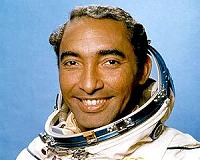 |
Houston TX (SPX) May 02, 2011 The very idea of spiders in space brings to mind campy, black and white horror films involving eight-legged monsters. In actuality, it is a scientific investigation called Commercial Generic Bioprocessing Apparatus Science Insert-05 or CSI-05, in which researchers observe arachnid habits in a microgravity environment. This is the second spider investigation on the International Space Station-the first was CSI-03-and researchers have high hopes that the sequel will eclipse the original. Scheduled to launch April 29, 2011 with STS-134, the spider habitat will transfer from the space shuttle Endeavour to the space station. Once aboard, the crew will place the two habitats into the Commercial Generic Bioprocessing Apparatus or CGBA. This equipment will maintain a consistent temperature, humidity and lighting cycle for the spiders and their sustenance supply of fruit flies. The CGBA also controls imaging for the investigation. The spider pair currently planned for investigation with CSI-05 are both golden orb spiders (Nephila clavipes), which spin a three dimensional, asymmetric web. This is different from the two orb spiders (Larinioides patagiatus and Metepeira) that launched to the space station on STS-126, which were selected specifically for the symmetry of their web formation. Scientists are looking to see if and how the arachnids will spin their webs differently in microgravity. The results will help them to understand the behavioral role of gravity for the spiders and their fruit fly companions. "I think people can relate to everyday insects and they can understand why the experiment is of interest," said Stefanie Countryman, coordinator for CSI-05. "Plus, the visual aspects of this experiment make it very appealing to the general public." When a sequel does top the original, in science as in movies, it usually has something to do with lessons learned during the first production. The CSI-03 investigation, for instance, was unfortunately restricted to eight days, due to the spiders' fruit flies food 'sliming' the observation window. This obscured the view inside the habitat and limited the study. For CSI-05, which is funded by the National Space Biomedical Research Institute or NSBRI and the NASA National Lab Education Office, the fruit flies will have a separate compartment from the spiders. The crew will slowly introduce the flies-approximately every four days-into the two individual spider habitats, which should allow for clear imagery through the viewing window for the full 45-day duration of the investigation. The fruit flies are not, however, simply nourishment for the spiders. They are actually a secondary study themselves. Scientists plan to look at their mobility over time to see if and how they react to the microgravity environment. They should be able to observe growth, behavioral and flight patterns as the flies develop. There also is an important education element to this investigation, sponsored by Baylor College of medicine Center for Educational Outreach and Orion's Quest. While the N. clavipes is spinning in space, students on Earth will develop and observe their own spider habitats. Teachers can use a curriculum found on bioedonline.org. This Web site includes daily images sent from the space station to the BioServe Payload Operations and Control Center. This allows students to compare their spiders' spinning habits to those of the spiders in microgravity in near real time. Orion's Quest Web site-orionsquest.org-will focus on the habits of the fruit flies in space.
Share This Article With Planet Earth
Related Links Johnson Space Center Space Tourism, Space Transport and Space Exploration News
 First Cuban cosmonaut receives award from Russian government
First Cuban cosmonaut receives award from Russian governmentHavana, Cuba (XNA) Apr 29, 2011 The visiting vice leader of the Russian State Duma Wednesday conferred the "Russian Order of Friendship" on Arnaldo Tamayo Mendez, the first Cuban and Latin American cosmonaut. The award, granted by Russian President Dmitry Medvedev, "reflects the great contribution of Tamayo to the relations between both nations, as the first cosmonaut of the island-nation and as the president of the parl ... read more |
|
| The content herein, unless otherwise known to be public domain, are Copyright 1995-2010 - SpaceDaily. AFP and UPI Wire Stories are copyright Agence France-Presse and United Press International. ESA Portal Reports are copyright European Space Agency. All NASA sourced material is public domain. Additional copyrights may apply in whole or part to other bona fide parties. Advertising does not imply endorsement,agreement or approval of any opinions, statements or information provided by SpaceDaily on any Web page published or hosted by SpaceDaily. Privacy Statement |